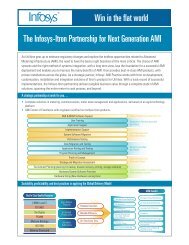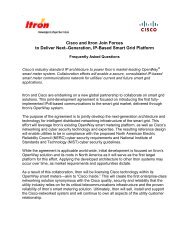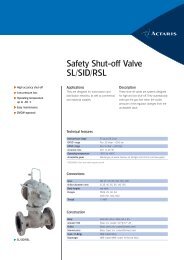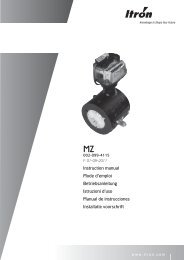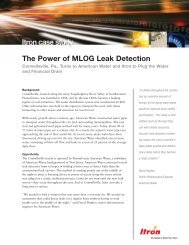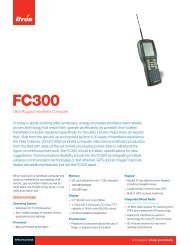OpenWay Security Overview - Itron
OpenWay Security Overview - Itron
OpenWay Security Overview - Itron
Create successful ePaper yourself
Turn your PDF publications into a flip-book with our unique Google optimized e-Paper software.
<strong>OpenWay</strong> ® <strong>Security</strong><br />
<strong>Overview</strong><br />
Scott Palmquist<br />
Sr. Product Manager<br />
Ido Dubrawsky<br />
Sr. Principal Systems Engineer<br />
© 2011, <strong>Itron</strong> Inc. All rights reserved. 1
Introduction 3<br />
Regulatory and Industry Drivers 4<br />
NISTIR 7628 4<br />
NERC Critical Infrastructure Protection 5<br />
Smart Grid Threats 5<br />
<strong>OpenWay</strong> Architecture 6<br />
<strong>OpenWay</strong> <strong>Security</strong> 9<br />
Conclusion 12<br />
2 © 2011, <strong>Itron</strong> Inc. All rights reserved.
<strong>OpenWay</strong> <strong>Security</strong><br />
Introduction<br />
The smart grid represents an evolution transformation in the way electricity is delivered from suppliers and the way<br />
it is used by consumers. With a smart grid, electricity is controlled throughout the delivery system via a two-way<br />
digital communication channel to appliances within a consumer’s premise to save energy, shift peak load, reduce<br />
costs and increase reliability. To that end, smart meters play a key role as a communication, monitoring and control<br />
device in the overall evolution of the power distribution system. With this evolution comes significant challenges in<br />
ensuring that the smart grid is both secure and reliable.<br />
Smart grid and smart metering systems promise to deliver on a wide variety of capabilities, including dynamic<br />
pricing by electric service providers (ESPs); increased customer control of their energy usage and ESP rates; fine-<br />
grained demand-response by ESPs in conjunction with customers; and improved reliability of the electric grid. A<br />
well-designed security architecture is an absolute requirement in order to provide these capabilities. Threats to<br />
smart grid systems come from a wide range of sources, or “threat agents.” These include unethical customers,<br />
curious and motivated eavesdroppers as well as active and passive attackers (LeMay, Gross, Gunter, & Garg, 2007).<br />
The motivations of these threat agents vary from publicity seekers to those with a focused and directed agenda.<br />
Regardless of the specific attacker’s motives, threats can include unauthorized access to communications;<br />
interruption of service; and injection of commands into the system to gain access and control either core systems or<br />
meters.<br />
The ultimate concern, from a national security perspective, is one where a rogue or enemy state or a terrorist<br />
organization cripples the electric power grid during a conflict or as part of an organized attack. To address these<br />
concerns, smart grid vendors are developing secure, resilient architectures that are designed to withstand both casual<br />
and focused attacks. These architectures require strong authentication and encryption to protect both core systems<br />
as well as meters from both amateur and sophisticated adversaries.<br />
The electric grid has changed dramatically over the past 20 years and will change even more in the years ahead. In<br />
the past, the standard meter on the grid was a very simple device measuring monthly electricity usage that required<br />
manual, visual readings by meter readers. Over time, meters became more sophisticated to include a radio broadcast<br />
capability where the meter can be read without physically approaching it. More recently, automated meter reading<br />
(AMR) has evolved into advanced metering and smart grid initiatives where meters can now receive commands as<br />
well as requests for meter readings over a radio-based local area network (RFLAN), as well as provide data at<br />
regular intervals to the utility billing system. These capabilities are necessary as the power generation grid evolves<br />
to include a larger portfolio of renewable and/or distributed energy generation sources such as solar and wind.<br />
© 2011, <strong>Itron</strong> Inc. All rights reserved. 3
Regulatory and Industry Drivers<br />
As smart grid and smart metering initiatives have gained momentum, and utilities look to deploy these technologies<br />
more broadly, an obvious concern turns toward the security of these systems. One of the key factors that drive this<br />
concern is the North American Electric Reliability Corporation (NERC), which has been chartered by the Federal<br />
Energy Regulatory Commission (FERC) to develop and drive critical infrastructure protection (CIP) requirements<br />
for the electric grid. The NERC CIP requirements cover a wide range of topics—from sabotage reporting to cyber<br />
security and critical cyber system identification to cyber security to personnel training, as well as other topics.<br />
These requirements are written in a broad enough fashion to allow the energy providers the ability to tailor their<br />
cyber security policies in order to be in compliance.<br />
While the NERC CIP guidelines do not explicitly state what is or what is not a critical cyber asset (CCA), it does<br />
provide sufficient guidelines that could include most smart grid deployments as CCAs. NERC CIP-002 provides the<br />
criteria for determining whether something is or isn’t a critical cyber asset. These criteria include:<br />
• Control and backup control centers<br />
• Transmission substations<br />
• Generation resources<br />
• Systems and facilities critical to system restoration.<br />
• Systems and facilities capable of shedding 300 MW or more.<br />
• Any additional assets that support the reliable operation of the Bulk Electric System (North American<br />
Electric Reliability Corporation, 2009)<br />
In addition to NERC, other organizations have been developing guidelines for smart grid security. These include the<br />
National Institute of Standards and Technology (NIST) and the AMI-SEC Task Force (TF). NIST published NIST<br />
IR 7628 in September of 2010 covering smart grid security guidelines. This work covers both an overall smart grid<br />
security strategy as well as privacy concerns in a smart grid. The AMI-SEC Task Force published version 2.0 of<br />
the AMI <strong>Security</strong> Profile in June of 2010.<br />
NISTIR 7628<br />
The NISTIR 7628 – Guidelines for Smart Grid Cyber <strong>Security</strong> – is divided into three volumes. Volume one covers<br />
smart grid security strategy, architecture and high-level requirements; volume two covers privacy in the smart grid;<br />
volume three provides supportive analyses and references for the overall work. One key aspect that must be<br />
considered when evaluating the information in the NISTIR document is that the information in the report is written<br />
to provide organizations planning a smart grid deployment with guidelines. The NISTIR does not prescribe<br />
particular solutions but rather requires organizations to leverage the information in the documents and develop their<br />
own cyber security approach as well as a risk assessment methodology for the smart grid. It is essential that any<br />
4 © 2011, <strong>Itron</strong> Inc. All rights reserved.
<strong>OpenWay</strong> <strong>Security</strong><br />
utility looking to deploy their own smart grid infrastructure should leverage the information in the NISTIR 7628<br />
documents in order to develop their cyber security policies with respect to smart grid and AMI.<br />
NERC Critical Infrastructure Protection<br />
NERC CIP is currently divided into a series of nine documents – NERC CIP-001 to NERC CIP-002. These NERC<br />
CIP standards specify requirements that are policy and process focused rather than technology focused. The key<br />
NERC CIP documents that apply most directly to a smart grid or AMI deployment include the following:<br />
• NERC CIP-002 – Critical Cyber <strong>Security</strong> Asset Identification<br />
• NERC CIP-003 – <strong>Security</strong> Management Controls<br />
• NERC CIP-005 – Electronic <strong>Security</strong> Perimeters<br />
• NERC CIP-006 – Physical <strong>Security</strong> of Critical Cyber Assets<br />
• NERC CIP-007 – Systems <strong>Security</strong> Management<br />
• NERC CIP-008 – Cyber <strong>Security</strong> – Incident Reporting and Response Planning<br />
It is important to note that the requirements in the NERC CIP standards do not speak to a specific technology<br />
directly but rather help drive the necessary technology standards.<br />
Smart Grid Threats<br />
A smart grid deployment presents significant challenges to the security architect in providing a defense against a<br />
wide variety of threats. The majority of the smart grid components—the smart meters themselves—are located at<br />
the end user’s facility (either home or business), and are considered to be in an extremely hostile environment.<br />
Theoretically, an attacker can have nearly 24/7 access to the component in order to identify a vulnerability or devise<br />
an attack. In addition to environmental and physical threats, smart grid components must also contend with a wide<br />
variety of electronic threats such as hacking and denial of service. Given the nature of the smart grid, there are<br />
several general categories of attack against it. These threats are shown in Figure 1 and pertain to the following smart<br />
grid/AMI system components:<br />
• The smart meters<br />
• The RFLAN<br />
• The wireless devices bridging the RFLAN to the wide area network (WAN)<br />
• The WAN providing backhaul for the RFLAN<br />
• The collection system head-end<br />
© 2011, <strong>Itron</strong> Inc. All rights reserved. 5
Figure 1 – Potential Threat Points in an AMI Deployment<br />
Given the unique nature of smart grid deployments operating in an exposed and actively hostile environment, it is<br />
critical that the security of the components be comprehensive and of the highest caliber and scrutinized in detail. To<br />
address these threats and needs, smart grid components must leverage strong software and hardware development<br />
processes that include threat modeling, a software development lifecycle and security testing to identify potential,<br />
undiscovered vulnerabilities and to remediate them before the components are released to the market.<br />
<strong>OpenWay</strong> Architecture<br />
The <strong>OpenWay</strong> architecture is designed to provide flexibility as well as robust security in a smart grid deployment.<br />
AMI systems could be classified as CCAs according to NERC CIP-002-3, as they often comprise systems capable of<br />
automatic load shedding of 300MW or more (R1.2.5) and because they utilize a routable protocol to communicate<br />
outside the Electronic <strong>Security</strong> Perimeter (R3.1) (North American Electric Reliability Corporation, 2009). <strong>Itron</strong>’s<br />
<strong>OpenWay</strong> architecture is designed to address the specific security requirements of a smart grid deployment.<br />
6 © 2011, <strong>Itron</strong> Inc. All rights reserved.
<strong>OpenWay</strong> <strong>Security</strong><br />
The <strong>OpenWay</strong> solution consists of several primary components: <strong>OpenWay</strong> CENTRON ® meters, <strong>OpenWay</strong> Cell<br />
Relays and a head-end system known as the <strong>OpenWay</strong> Collection Engine. Figure 2 shows the <strong>OpenWay</strong><br />
architecture’s Enhanced <strong>Security</strong> Configuration. Together, all of these components play in integral part in securing<br />
a deployment and these components and associated security measures are discussed in more detail below.<br />
Figure 2 – <strong>Itron</strong>’s <strong>OpenWay</strong> Smart Grid Architecture Enhanced <strong>Security</strong> Configuration<br />
Collection Engine<br />
The <strong>OpenWay</strong> collection engine is the core of the <strong>OpenWay</strong> solution. Built upon the Windows .NET framework,<br />
the collection engine provides both inbound data collection services from the infrastructure as well as outbound<br />
meter command and key management. The Collection Engine is responsible for supporting the integrity of the<br />
system.<br />
© 2011, <strong>Itron</strong> Inc. All rights reserved. 7
RFLAN and Cell Relay Communications<br />
The <strong>OpenWay</strong> radio frequency LAN (RFLAN) is a frequency-hopping RF network that utilizes the 900 MHz ISM<br />
band. Messages are transmitted in accordance with the ANSI C12.22 protocol, and are encrypted using 128-bit AES<br />
keys. The command messages are also signed using ECC public/private keys.<br />
The Collection Engine interfaces with meters through Cell Relays. Firewalls are recommended between portions of<br />
the system; however, the <strong>OpenWay</strong> architecture requires full two-way communication between the Collection<br />
Engine and the Cell Relay. The Collection Engine can be placed behind a firewall and allow traffic on port 1153<br />
(C12.22) to pass through. The Collection Engine needs to be able to access its database as well as the enterprise<br />
management system and the meter data management (MDM) application. These applications may be behind<br />
additional firewalls, or they may be on the same network as the Collection Engine itself, provided that the Collection<br />
Engine has full two-way access to the appropriate ports for data transfer. This initial communication is done using<br />
TCP/IP. As either the Collection Engine or the Cell Relay can initiate communications, both products must accept<br />
incoming C12.22 messages on TCP/IP port 1153. The Collection Engine listens on port 1153 for C12.22<br />
communication and monitors the network for Web services calls.<br />
<strong>OpenWay</strong> CENTRON Meters<br />
The C12.22 architecture plays an important role regarding the implementation of security. The major benefit of the<br />
design of a C12.22 network is that the Collection Engine interfaces at an application level protocol layer, enabling<br />
both session- and sessionless-based communication directly to the meter register. Unlike designs tied to a single<br />
communications network, with <strong>OpenWay</strong> the security architecture does not need to change if the communication<br />
architecture changes. <strong>OpenWay</strong> <strong>Security</strong> protects the entire communication from the head-end-system into the<br />
processor in the meter, giving the utility flexibility to select an underlying communications’ infrastructure<br />
appropriate to the utilities strategic needs.<br />
<strong>OpenWay</strong> also benefits from the ability to perform broadcast and multicast communications to meters, minimizing<br />
the amount of messages that require encryption and processing, as opposed to sending multiple messages point to<br />
point to meters.<br />
<strong>Security</strong> Event Manager<br />
As with any deployed IT system security, events must be monitored and evaluated in order to determine if a<br />
potential security breach has occurred, and if so, how to appropriately respond to it. One of the key features of a<br />
security event manager (SEM) in a smart grid deployment is the ability to accurately identify a developing or<br />
ongoing attack against the system. Attacks can vary considerably but include such threats as:<br />
• An attacker attempting to shut off a population of meters<br />
• An attacker trying to obtain key material from the system<br />
8 © 2011, <strong>Itron</strong> Inc. All rights reserved.
<strong>OpenWay</strong> <strong>Security</strong><br />
• An attacker attempting to execute a denial of service attack against a population of meters<br />
• An attempt to hijack or spoof on or more trusted systems<br />
• Attempts to recover key material from endpoints<br />
• Attempts to modify an endpoint to change metrology or other parameters<br />
The above events represent a sample of possible events that should be monitored by a security event manager.<br />
A SEM is deployed to collect, correlate and analyze audit events in order to detect intrusions and attacks. Examples<br />
of audit events in <strong>OpenWay</strong> include but are not limited to: endpoint reprogramming, endpoint authentication failure,<br />
signature verification failure, message decryption failure, home area network (HAN) traffic rate exceeding<br />
threshold, device firmware upgrade and spurious HAN and local area network (LAN) messages. These events are<br />
primarily generated at the meter or from wide area network (WAN) devices and sent to the <strong>OpenWay</strong> Collection<br />
Engine, which then sends the events to the security event monitor.<br />
<strong>OpenWay</strong> <strong>Security</strong><br />
<strong>OpenWay</strong> Enhanced <strong>Security</strong> provides for both the confidentiality of data and commands, and also provides data<br />
integrity and non-repudiation for commands from the Collection Engine to the endpoints. New threats and looming<br />
regulatory requirements have driven the need for a higher level of security. To fulfill that need, <strong>OpenWay</strong> provides<br />
a strong security layer in a smart grid deployment known as Enhanced <strong>Security</strong>. Enhanced <strong>Security</strong> leverages public<br />
key cryptography in addition to symmetric key cryptography to secure the communication between the Collection<br />
Engine and the meter endpoint. Asymmetric cryptography is used to provide digital signatures for command<br />
verification and symmetric cryptography is used to provide data confidentiality. <strong>OpenWay</strong> also supports the<br />
following security standards for security controls and functions:<br />
• NIST FIPS 197 approved encryption algorithms (AES)<br />
• NIST FIPS 186-3 approved signature algorithms (ECDSA)<br />
• NIST FIPS 180-2 approved hashing algorithms (HMAC-SHA-1,HMAC-SHA-256)<br />
Collection Engine with Enhanced <strong>Security</strong><br />
The Collection Engine is responsible for supporting the integrity of the control of the system. As a result,<br />
asymmetric cryptography is supported for command and control messages. Every node in the system has a set of<br />
asymmetric keys that are used for authentication and non-repudiation functions. Initial meter registration involves a<br />
key exchange process that establishes mutual authentication. When sending out messages, the C12.22 payload is<br />
signed and encrypted before being wrapped it in the C12.22 protocol. This is accomplished by the integrated Signing<br />
and Encryption appliance. As control over this operation is absolutely critical to ensuring control over the system,<br />
the Signing and Encryption Server will never expose the signing key. When the meter communicates information<br />
© 2011, <strong>Itron</strong> Inc. All rights reserved. 9
upstream to the Collection Engine, the C12.22 messages are encrypted to protect the confidentiality of data and<br />
decrypted by the DKUS appliance. An overview of this exchange is depicted in Figure 3.<br />
Enhanced <strong>Security</strong> with <strong>OpenWay</strong> CENTRON Meters<br />
With <strong>OpenWay</strong> Enhanced <strong>Security</strong>, cryptographic processing at the meter is done using algorithms recommended<br />
by the National <strong>Security</strong> Agency under their "Suite B" recommendations for commercial security. Elliptic Curve<br />
Cryptography (ECC) provides the most security per bit of any known public-key scheme. Leveraging enhanced<br />
security provides not just confidentiality for the information flow between the Collection Engine and the meter but<br />
also message integrity. This makes it considerably more difficult for an attacker to inject falsified messages into the<br />
system either from the Collection Engine to the meter or from the meter to the Collection Engine. Each <strong>OpenWay</strong><br />
CENTRON meter has a unique private key, which is used to validate digitally signed commands received from the<br />
Collection Engine and to authenticate the meter to the Collection Engine during initial meter registration.<br />
Messages from the Collection Engine to the Meter<br />
Messages from the Collection Engine to the meter are encrypted using an AES-128 bit key and signed using an<br />
ECC-283 bit key as shown in Figure 3. The <strong>OpenWay</strong> security architecture allows for broadcast and multicast<br />
communications, where a single message from the Collection Engine can direct behavior for a large number,<br />
potentially millions, of meters simultaneously as well as for unicast communications. Signature verification and<br />
decryption is pushed out to the meters in a distributed fashion. The meter processes these security functions in<br />
milliseconds once the command is received. Thus, while each meter will need to validate the signature on the<br />
message to ensure its authenticity, those validations occur in parallel resulting in very little latency being added to a<br />
group operation no matter how many meters are involved. At the collection engine, the system can easily sign and<br />
encrypt 200 operations per second.<br />
Messages from the Meter to the Collection Engine<br />
Messages from the meter to the Collection Engine are encrypted using an AES-128 bit key to provide customer data<br />
confidentiality as shown in Figure 3. The <strong>OpenWay</strong> architecture is optimized such that an IP load balancer shapes<br />
the incoming traffic and distributing it equally among the Collection Engine subcomponents for processing. The<br />
Collection Engine removes the network portion of the packet and passes the payload to the <strong>OpenWay</strong> Decryption<br />
and Key Update Server for processing. This appliance is scaled to decrypt 20,000 messages per second, which maps<br />
out to over a million meters per minute processing.<br />
10 © 2011, <strong>Itron</strong> Inc. All rights reserved.
<strong>OpenWay</strong> <strong>Security</strong><br />
Figure 3 – Enhanced <strong>Security</strong> in <strong>OpenWay</strong><br />
The security architecture was designed specifically for <strong>OpenWay</strong> operational use cases centered on performing<br />
multiple functions such as meter data collection, demand response and remote disconnects simultaneously for 10<br />
million meters or more. It is important to note that while command and control messages are signed all command,<br />
control and data messages are encrypted. In addition, the <strong>OpenWay</strong> SES and DKUS security appliances are<br />
designed so one appliance pair can handle the message traffic of a system with 10 million devices. Customers need<br />
only install additional appliances for high availability and disaster recovery, not performance.<br />
Signing and Encryption Server (SES)<br />
The Signing and Encryption Server is responsible for securing command messages being sent from the Collection<br />
Engine to the meters. As a result, the number of keys managed for these messages is quite small, potentially as little<br />
as two keys that need active control. However, these keys must be very tightly controlled to ensure that the system is<br />
not compromised. The private signing key of the Collection Engine is never exposed in raw form, though there are<br />
facilities to back it up. To protect the keys, the Signing and Encryption Server includes an integral hardware security<br />
module (HSM). The HSM is FIPS 140-2 level 3 compliant, meaning that it is meets the government guidelines to<br />
protect the keys it contains against both physical and electronic attacks.<br />
Decryption and Key Update Server (DKUS)<br />
This component provides rapid message decryption and comprehensive key management. Messages coming from<br />
the meters to the Collection Engine need to be quickly decrypted. In a large-scale <strong>OpenWay</strong> implementation, the<br />
system can decrypt more than 20,000 messages a second, each with its own unique key. While the messages are<br />
small, over the course of several hours, the system may need to decrypt messages using between 5 and 10 million<br />
unique AES keys. The solution must be able to quickly handle accessing millions of keys, decrypting thousands of<br />
messages and passing them on to the Collection Engine.<br />
© 2011, <strong>Itron</strong> Inc. All rights reserved. 11
System <strong>Security</strong><br />
The <strong>OpenWay</strong> Collection Engine uses role-based security for authenticated users. Administrators can be assigned<br />
different levels of privileges with each administrator using an individual password. Administrators can also be<br />
integrated into Microsoft’s Active Directory. Administrator web access to the Collection Engine is protected using<br />
X.509 certificates and TLS for session encryption. In addition, the Collection Engine is always installed in the<br />
utility’s data center behind its firewall and intrusion prevention systems.<br />
Data Management programs, such as a Meter Data Management System (MDMS), which access the Collection<br />
Engine to instruct the collection engine to issue a command to the meter endpoint, are authenticated through X.509<br />
Certificates and the communications is kept confidential through the use of TLS. The Collection Engine’s data<br />
management interface can also use Secure Assertion Markup Language (SAML) or Kerberos if these techniques are<br />
supported by the MDM.<br />
Conclusion<br />
In summary, <strong>OpenWay</strong>’s security architecture is designed specifically for key security functions, without sacrificing<br />
the performance requirements that are needed for two-way command and control for AMI and smart grid network<br />
operations. The <strong>OpenWay</strong> security architecture provides customers the ability to comply with applicable NERC and<br />
FIPS requirements to protect their smart grid network. In addition, <strong>OpenWay</strong> security supports the operational<br />
requirements of <strong>OpenWay</strong> to support up to 10 million meters without impacting the system’s performance managing<br />
upstream and downstream message processing. <strong>OpenWay</strong>’s architecture also reduces the complexity around security<br />
through the use of C12.22 and node-to-node communication between the Collection Engine and the meter register.<br />
12 © 2011, <strong>Itron</strong> Inc. All rights reserved.
<strong>OpenWay</strong> <strong>Security</strong><br />
<strong>Itron</strong> Inc.<br />
At <strong>Itron</strong>, we’re dedicated to delivering end-to-end smart grid and smart distribution solutions to electric, gas and<br />
water utilities around the globe. Our company is the world’s leading provider of smart metering, data collection and<br />
utility software systems, with nearly 8,000 utilities worldwide relying on our technology to optimize the delivery<br />
and use of energy and water. Our offerings include electricity, gas, water and heat meters; network communication<br />
technology; collection systems and related software applications; and professional services. To realize your smarter<br />
energy and water future, start here: www.itron.com.<br />
<strong>Itron</strong> Inc.<br />
Corporate Headquarters<br />
2111 North Molter Road<br />
Liberty Lake, Washington 99019<br />
U.S.A.<br />
Tel.: 1.800.635.5461<br />
Fax: 1.509.891.3355<br />
Due to continuous research, product improvement and enhancements, <strong>Itron</strong> reserves the right to change product or system specifications without notice. <strong>Itron</strong> is a registered trademark<br />
of <strong>Itron</strong> Inc. All other trademarks belong to their respective owners. © 2011, <strong>Itron</strong> Inc. Publication 100933WP-042/11<br />
© 2011, <strong>Itron</strong> Inc. All rights reserved. 13



